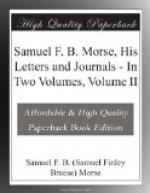In the face of these enthusiastic, if somewhat stilted, periods the majority of his colleagues remained cold, and no appropriation was voted. Morse, however, was prepared to meet with discouragements, for he wrote to Vail on March 15:—
“Everything looks encouraging, but I need not say to you that in this world a continued course of prosperity is not a rational expectation. We shall, doubtless, find troubles and difficulties in store for us, and it is the part of true wisdom to be prepared for whatever may await us. If our hearts are right we shall not be taken by surprise. I see nothing now but an unclouded prospect, for which let us pay to Him who shows it to us the homage of grateful and obedient hearts, with most earnest prayers for grace to use prosperity aright.”
This was written while there was still hope that Congress might take some action at that session, and Morse was optimistic. On March 31, he thus reports progress to Vail:—
“I write you a hasty line to say, in the first place, that I have overcome all difficulties in regard to a portrule, and have invented one which will be perfect. It is very simple, and will not take much time or expense to make it. Mr. S. has incorporated it into the specification for the patent. Please, therefore, not to proceed with the type or portrule as now constructed: I will see you on my return and explain it in season for you to get one ready for us.
“I find it a most arduous and tedious process to adjust the specification. I have been engaged steadily for three days with Mr. S., and have not yet got half through, but there is one consolation, when done it will be well done. The drawings, I find on enquiry, would cost you from forty to fifty dollars if procured from the draughtsman about the Patent Office. I have, therefore, determined to do them myself and save you that sum.”
The portrule, referred to above, was a device for sending automatically messages which were recorded permanently on the tape at the other end of the line. It worked well enough, but it was soon superseded by the key manipulated by hand, as this was much simpler and the dots and dashes could be sent more rapidly. It is curious to note, however, that down to the present day inventors have been busy in an effort to devise some mechanism by which messages could be sent automatically, and consequently more rapidly than by hand, which was Morse’s original idea, but, to the best of my knowledge, no satisfactory solution of the problem has yet been found.




